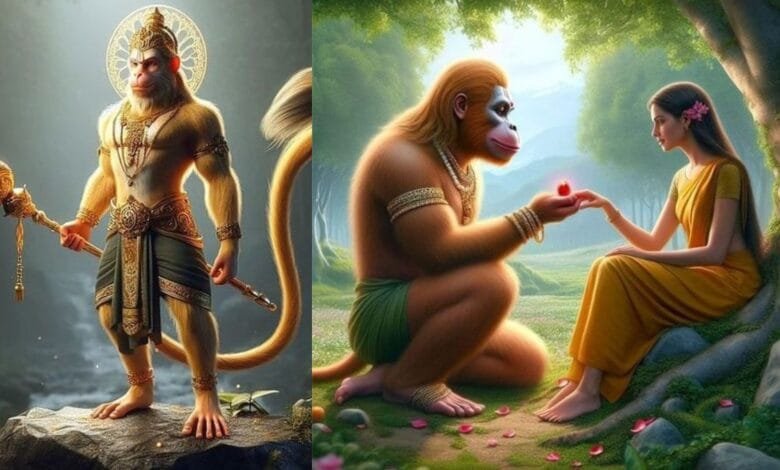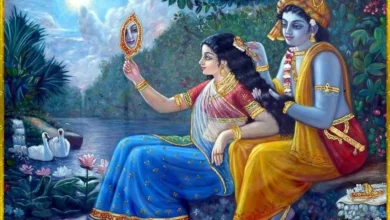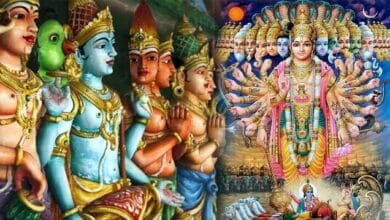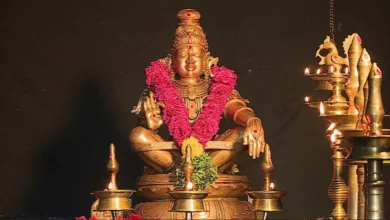Hanuman Ji’s Divine Marriage: The Untold Story of Suvarchala

In the vast tapestry of Hindu mythology, Lord Hanuman is universally revered as the epitome of celibacy and unwavering devotion. However, there exists a lesser-known narrative that speaks of his sacred marriage to Suvarchala, the daughter of Surya Dev. This divine union, far from contradicting his vow of brahmacharya, actually reinforces the depth of his commitment to dharma and knowledge.
The Guru-Shishya Bond with Surya Dev
According to ancient scriptures, when Hanuman Ji approached Surya Dev for education, he faced a unique challenge. The Sun God, bound by the nature of his cosmic duties, could never remain stationary. Undeterred by this obstacle, Hanuman Ji demonstrated his extraordinary dedication by constantly moving alongside his divine teacher, absorbing knowledge while traversing the celestial paths.
Surya Dev began imparting all forms of wisdom to his exceptional disciple. The curriculum consisted of nine sacred vidyas (knowledge systems), each representing different aspects of universal wisdom. Hanuman Ji’s brilliance and devotion made him an ideal student, and he progressed rapidly through the teachings.
The Dharmic Dilemma
After Hanuman Ji successfully mastered five of the nine vidyas, an unexpected situation arose. The remaining four sacred knowledge systems carried a specific prerequisite – they could only be transmitted to someone who was married. This ancient restriction was not arbitrary but rooted in the understanding that certain profound teachings required the energy balance that comes with the grihastha (householder) stage of life.
This created a dharmic dilemma for both guru and disciple. Hanuman Ji had taken a solemn vow to complete his education fully, yet he was also committed to lifelong celibacy. Surya Dev, as a responsible guru, could not withhold knowledge from a worthy student, nor could he violate the sacred protocols of knowledge transmission.
The Sacred Solution
To resolve this spiritual conundrum, Surya Dev proposed an extraordinary solution. He suggested that Hanuman Ji marry his daughter Suvarchala, who herself was a paragon of spiritual discipline and radiance. Suvarchala was known for her intense tapasya (penance) and luminous spiritual energy, making her uniquely suited for this divine arrangement.
Understanding the higher purpose behind this union, Hanuman Ji agreed to the marriage. This decision was not taken lightly but emerged from his commitment to acquiring complete knowledge for serving Lord Ram and humanity at large. The marriage was solemnized according to Vedic rituals, fulfilling the technical requirement for receiving the remaining teachings.
The Essence of This Union
Once Hanuman Ji completed his education under Surya Dev’s guidance, he immersed himself completely in the service of Lord Ram. Meanwhile, Suvarchala returned to her life of intense spiritual practice and meditation. This arrangement meant that while the marriage existed in form, both partners maintained their individual spiritual paths without any worldly entanglement.
The Parashar Samhita explicitly clarifies the nature of this marriage. According to this authoritative text, Surya Dev himself defined this union as one undertaken for the welfare of the universe (brahmanda kalyan). He emphasized that this sacred arrangement would have no impact whatsoever on Hanuman Ji’s brahmacharya. The marriage existed on a different plane – one of cosmic necessity rather than physical or emotional bonding.
The Living Testimony: Khammam Temple
In Khammam district of Telangana stands a unique temple that serves as physical evidence of this sacred narrative. Unlike most Hanuman temples where the deity appears in his celibate warrior form, this temple depicts Hanuman Ji in his grihastha (householder) avatar, seated alongside his consort Suvarchala.
This temple holds special significance for married couples. According to local beliefs and experiences of devotees, visiting this shrine and seeking the blessings of Hanuman Ji with his divine consort can help resolve marital discord, reduce tensions between spouses, and eliminate domestic conflicts. The temple represents the harmonious balance of duty, devotion, and dharma.
The Deeper Spiritual Message
This narrative offers profound insights into the nature of true brahmacharya and spiritual commitment. It demonstrates that celibacy is not merely physical abstinence but a state of consciousness where all energies are channeled toward the divine. Hanuman Ji’s marriage to Suvarchala shows that external circumstances or social arrangements need not disturb one’s inner spiritual state.
The story also highlights the principle that dharma sometimes requires us to take seemingly contradictory actions for a greater purpose. Hanuman Ji’s willingness to marry while maintaining his vow exemplifies the subtle understanding required to navigate complex spiritual situations.
Furthermore, this account emphasizes the supreme importance of complete knowledge. Hanuman Ji was unwilling to remain partially educated, recognizing that incomplete wisdom cannot serve humanity effectively. His determination to acquire all nine vidyas, regardless of the conditions required, reflects his dedication to becoming a perfect instrument for divine service.
The story of Hanuman Ji’s marriage to Suvarchala enriches our understanding of this beloved deity. It reveals dimensions of his character beyond the popular image of the celibate warrior – showing us a being who embodied dharma so completely that even marriage could not disturb his essential nature.
This narrative reminds us that spiritual truths often transcend conventional categories and simple binaries. The marriage that preserved celibacy, the union that maintained separation, the householder who remained a brahmachari – these apparent paradoxes point toward the profound flexibility and depth within our spiritual traditions.
For devotees visiting the Khammam temple or contemplating this sacred story, the message is clear: true spirituality lies not in rigid external observances but in the unwavering inner alignment with dharma and divine purpose that Hanuman Ji exemplifies in every aspect of his divine life.
Discover more from Sanatan Roots
Subscribe to get the latest posts sent to your email.



2 Comments